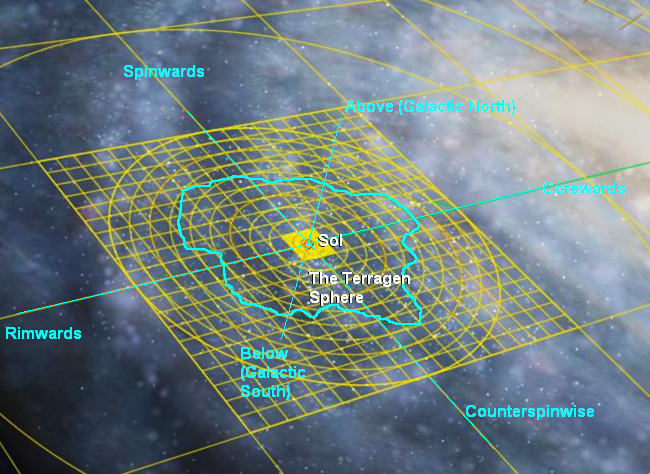BY LETTER
Galactic Directions
Science > Astronomy
Galactography
Galactography > Maps of the Terragen Sphere
Galactography > Regions of Space
Galactography
Galactography > Maps of the Terragen Sphere
Galactography > Regions of Space
 Image from Steve Bowers |
The Terragen Sphere is extended over a large part of the Orion Arm of the Milky Way Galaxy, and extends into the inner Sagittarius Arm and out to the Perseus Arm. It also extends above and below the main plane of the galaxy, although stars and colonies are spread more thinly there. But how are the various directions of the Terragen expansion defined?
Planetary terms like north, south, east, west, are insufficient for referring to directions within the galaxy. Instead, the following conventions have achieved widespread acceptance when referring to direction:
Toward the galactic core is coreward; away from it, in the direction of the rim, is rimward. In the direction in which the galaxy is rotating is spinward, and the opposite direction is counterspinward or trailing.
The widely used system of Galactic Cartesian Coordinates (generally known as Galactic xyz coordinates) give locations in terms of the distances along the xyz axes of a grid centred on Sol, with the x-axis being coreward, the y-axis spinward, and the z-axis towards Galactic North.
These standard translation between galactic directions and constellations is
above - Coma (Galactic North)
below - Sculptor (Galactic South)
corewards - Sagittarius
rimwards - Gemini or Taurus
spinwards - Cygnus
counterspinwise - Vela
Although these directions are widely used, sometimes the term coreward in the Outer Volumes is also used to indicate the direction of the Inner Sphere. There is some potential for confusion if the term is accepted out of context, and in the Astrographic Institute on Mekelon has recommended that Solward be used instead in this context.
Another source of confusion is the use of 'up' and 'down' by astrographers in the Communion of Worlds; these use a convention where 'up' means towards Galactic South, and 'down' means toward Galactic North. This may be due to the fact that many of the inhabitants of this empire originate from the southern Hemisphere of Old Earth, or possibly they use the alternate convention of 'rotational North' which is always taken from the anti-clockwise pole. The true reason is lost in the depths of galactic history.
Another way that directions are defined is by simply using the names of the ancient constellations as seen from Old Earth. Although most of these constellations are unrecognisable as soon as one travels more than a few tens of light years from Sol, the directions they define are still useful. Thus the Sagittarius Transcultural Cooperation is mostly located in the Sagittarius direction, while the Orion Federation is partly located in the Orion constellation as seen from Earth (although the capital is actually in Monoceros).
Most of the locations in the Orion's Arm Civilsation can be found in the sectors defined by those constellations which were aligned with the Milky Way as seen from the Solar System; these include Sagittarius, Scorpius, Ara, Norma, Lupus, Circinus, Centaurus, Crux, Carina, Vela, Puppis, Canis Major, Monoceros, Orion, Gemini, Taurus, Auriga, Perseus, Cassiopeia, Lacerta, Cepheus, Cygnus, Vulpecula, Sagitta, Aquila, Serpens and Scutum.
Related Articles
- Astrography
- Galactic Colonisation Board - Text by Steve Bowers
A quasi-religious body responsible for coordinating the exploration of the Outer Volumes (under divine guidance from the Sephirotic Archailects and their representatives). Currently based on Cythera. - Galactic Core
- Galactic History
- Galactic Information Bank
- Galaxy
- Galaxy, Spiral - Text by M. Alan Kazlev
A disk-shaped galaxy with a spiral pattern of arms, typically containing 1010 or more solar masses of stars, dust, and gas. - Milky Way
Appears in Topics
Development Notes
Text by Anders Sandberg, amended by Steve Bowers
Initially published on 09 October 2001.
Initially published on 09 October 2001.






